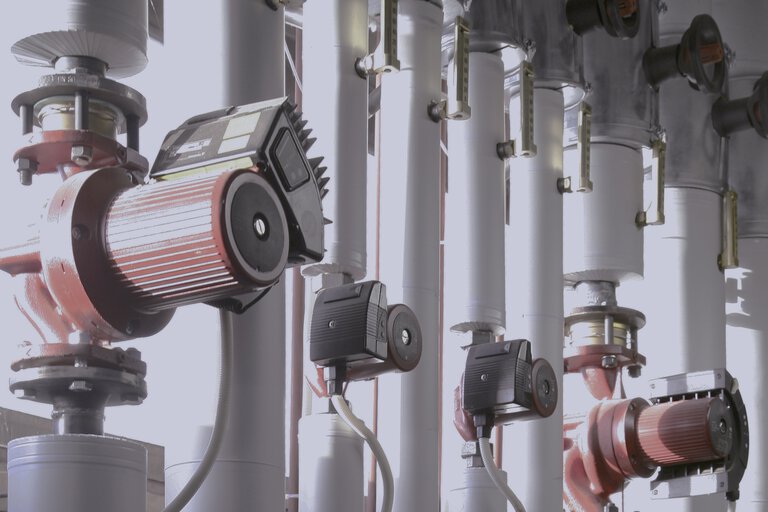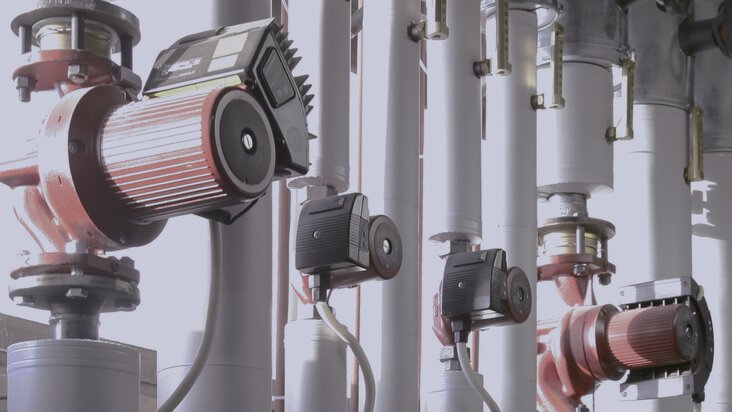
Temperature probes for heat meters – The most important facts at a glance
Temperature probes play a crucial role in correctly determining of energy consumption in heating and cooling systems. They enable accurate energy billing and help to optimize energy consumption. You can find out more about the function and importance of temperature probes and heat meters in the following FAQs.
Table of contents
What are heat meters
A heat meter or thermal energy meter is an instrument for measuring the thermal energy that is supplied to a consumer via a heating circuit or taken from a cooling circuit. The heat meter calculates the heat energy based on the volume flow of the circulating medium and the temperature difference between the flow and return. The temperature difference is determined using 2 temperature probes – usually resistance thermometers or digital temperature probes.

Heating circuit with temperature probes for heat meters in an apartment building with district heating supply
Why does the thermal energy supplied have to be determined?
Thermal energy must be measured wherever it is to be billed. This includes residential buildings, municipal facilities and industrial plants. With rising energy costs, consumption-based billing is becoming increasingly important and in many cases is even mandatory due to legal requirements.
Why should the temperature signal of the 2 probes only differ slightly?
The temperature probes measure the temperature in the flow and return of the heating circuit. The temperature difference is used to determine the thermal energy – this must be determined as accurately as possible. If the output signals of the two temperature probes differ too much, this leads to an inaccurate calculation of the energy consumption values. The temperature probes are therefore paired in accordance with EN 1434. This means that 2 probes are always combined whose output signals differ only slightly from each other.
Which sensors are used in the temperature probes for heat meters?
Mostly platinum chip temperature sensors with the nominal values of 100 Ω (Pt100) and1000 Ω (Pt1000) are used. However, Pt500s are also used.
How are temperature probes for heat meters designed in accordance with EN 1434-2?
The temperature probes for heat meters are usually designed as insertion probes. The thermowell diameter is usually 5.0, 5.2 or 6.0 mm. Alternatively, there are temperature probes with a connection head. The specific requirements and guidelines for the design of temperature probes for thermal energy meters are set out in EN 1434-2.
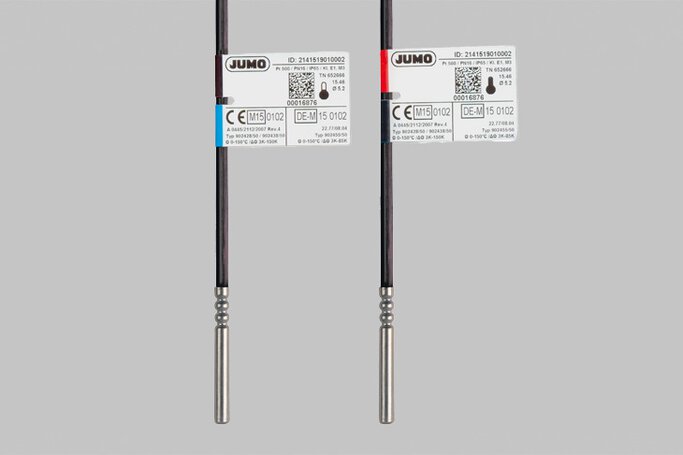
Plug-in temperature probe for heat meters
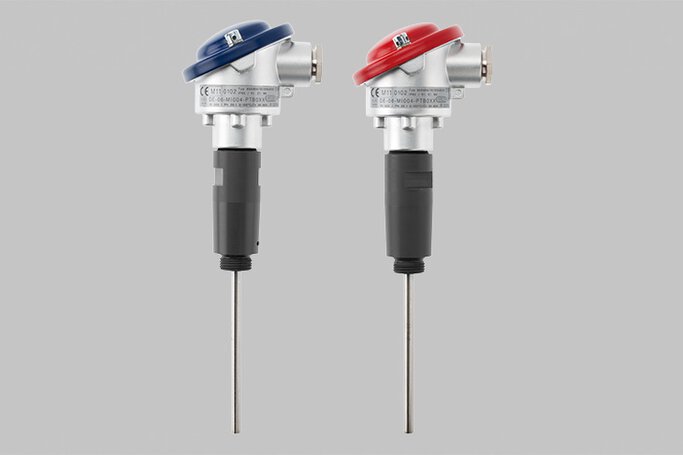
Temperature probe for heat meters with connection head
How do you connect the temperature probes?
As a rule, temperature probes are required for heat meters with a permanently connected connection cable. The connecting cables of the two temperature probes of an exchangeable pair with platinum chip temperature sensor must be the same length and must not be shortened. Otherwise, the different lead resistances - especially in the two-wire versions - would result in an additional measurement error.
In the case of temperature probes with a connection head, there is a connection socket in the connection head whose terminals are used to establish the connection to the temperature sensor. The two temperature probes with platinum chip temperature sensor must be connected by the customer using connecting cables of the same type and length.
According to EN 1434, there are maximum cable lengths above which the resistance thermometers must be connected using four-wire technology.
Why is it important that temperature probes can also be removed from pressurized systems?
The temperature probes in heat meters must be replaced regularly and checked if necessary. However, switching off the system pressure is generally not possible or is too time-consuming. There are two methods to ensure that the system is pressure-tight while the temperature sensor is being replaced.
Use of thermowells for temperature probes
If the measuring point is equipped with thermowells the temperature probes can be installed in them.
When the probes are removed, the process remains pressure-tight thanks to the thermowell alone, but the medium does not come into direct contact with the temperature probe. The thermowell causes the measurement to react with a delay and an additional heat dissipation error. In order to measure the temperatures as accurately as possible, we recommend installing the sensors directly without a thermowell.
Use of a ball valve for temperature probes
The direct installation of temperature probes is made possible by using ball valves in accordance with EN 1434. The ball valves have an M10 internal thread into which the temperature probes are screwed. The probe is therefore located in the ball valve and measures directly in the medium. When the ball valve is closed, the temperature probe is separated from the process. It can be removed without opening the process.

Screw-in thermowells: The screw shown on the screw-in sleeve is used to secure the temperature probe. The hole in the screw allows the measuring point to be sealed.
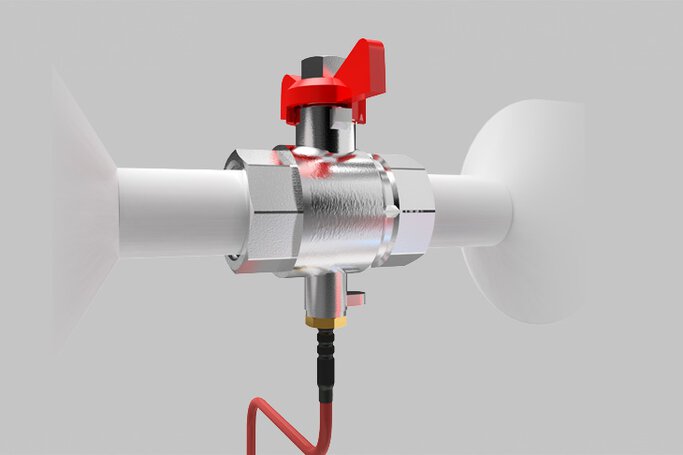
Ball valve with built-in temperature probe: The insertion probe can be fitted on site with an M10 plastic hinged screw connection or a brass screw connection and screwed into the ball valve.
Heat meter: Probe installation
The following video demonstrates step by step how to install a temperature probe correctly in the ball valve. This way, you can be sure that the installation is carried out correctly and that the sensor then provides reliable measured values.
What are the differences between symmetrical and asymmetrical installation of temperature sensors?
In our latest video, you will learn why the correct installation of temperature sensors is crucial for heat and cold meters. After all, the installation affects the measurement accuracy and the billing of energy costs.
We will explain not only the difference between symmetrical and asymmetrical installation, but also shed light on frequently underestimated effects such as the heat dissipation error. You will also learn about the role of immersion sleeves and how they influence the measured values. In addition, you will receive valuable tips for minimizing measurement errors and ensuring precise, reliable temperature measurements. Get the practical knowledge you need to avoid costly mistakes.
Let JUMO help you and click on the video!
When should temperature probes in heat meters be serviced or replaced?
In order to ensure precise and reliable measurement of thermal energy, the temperature probes should be metrologically checked regularly in accordance with the manufacturer's specifications or national requirements and replaced if necessary. In Germany, the calibration period for thermal energy measuring devices (heat meters) is 6 years.
The probe should also be checked in the event of inconsistent or obviously incorrect temperature measurements and after major repairs or modifications to the heating or cooling system.
- ${title}${badge}
